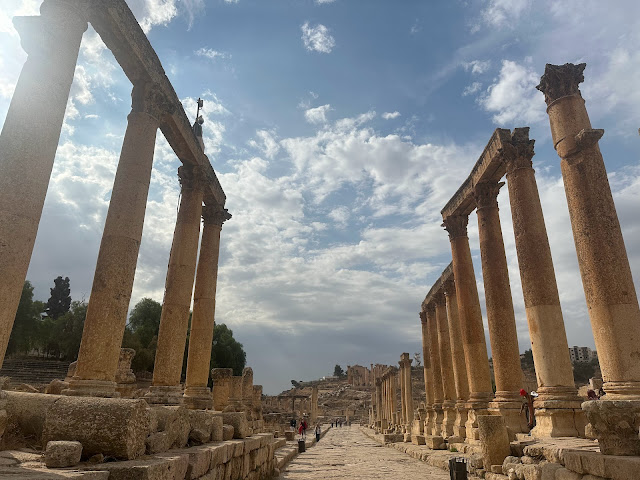Located in northern Jordan, Jerash is one of the largest and most well-preserved sites of Greek and Roman architecture in the world outside Italy. While the earliest evidence of human settlement in Jerash dates back to 7500 BCE during the Neolithic age, the city flourished during the Greek, Hellenistic, Roman, and Byzantine periods until its’ destruction by the Galilee earthquake in 749 CE and subsequent earthquakes.
 |
| The archeological site of Jerash |
The ruins of the
ancient Greek city of Gerasa sits
within the archeological site of Jerash. Gerasa is believed to be founded
by Alexander the Great (the king of the ancient Greek Kingdom of Macedonia from
336 BCE to 323 BCE) and his general Perdiccas, during the spring of 331 BCE in
order to settle aged Macedonian soldiers, when he left Egypt and crossed Syria
on his way to Mesopotamia (located in modern day Iraq). However, alternative
theories suggest that the city was founded by either Antiochus IV Epiphanes of
the Seleucid Empire (reigned from 175 BCE to 164 BCE) or Ptolemy II
Philadelphus who was the pharaoh of the Ptolemaic dynasty of Egypt from 284 BCE
to 246 BCE.
Around 80 BCE, Alexander
Jannaeus, who was the king of the Hasmonean dynasty of the Kingdom of Judea (reigned from 103 BCE to 76 BCE) conquered Gerasa and annexed it to the Kingdom of Judea. However, with the
Roman conquest in 63 BCE, the Jewish rule of Gerasa ended. During the Roman
period, Gnaeus Pompeius Magnus (commonly known as Pompey the Great) annexed Gerasa to "The Decapolis", a group of
ten Hellenistic cities on the eastern frontier of the Roman Empire in the
Southern Levant in the first centuries BCE and CE.
In 106 CE, Jerash was
absorbed into the Roman province of Arabia, which included the cities of Philadelphia
(modern day Amman), Petra (in southern Jordan) and Bostra (modern day Bosra in
southern Syria). During this period, the city achieved great prosperity due to
the peace and security ensured by the Romans. The visit of the Roman Emperor
Hadrian (reigned from 117 CE to 138 CE) somewhere between 129 CE and 130 CE was
celebrated with the construction of the Arch of Hadrian, which is visible
at Jerash today.
 |
| The Arch of Hadrian: Greco-Roman Period (Constructed around 129 CE/130 CE) |
 |
| The Southern Gate: Greco-Roman Period (Constructed around 129 CE/130 CE) |
 |
The Oval Forum: Greco-Roman Period (Constructed around 125 CE)
|
 |
| The Hippodrome: Greco-Roman Period (Constructed around 220 CE) |
 |
| The oil press: Greco-Roman Period (Constructed around 220 CE) |
.HEIC) |
| The Macellum (food market): Greco-Roman Period (Constructed around 190 CE) |
 |
| The Southern Necropolis: Greco-Roman Period (800 BCE - 130 CE) |
 |
| The Nymphaeum: Greco-Roman Period (Constructed around 190 CE/191 CE) |
 |
| The Sanctuary of Zeus Olympios: Greco-Roman Period (162 CE - 450 CE) |
 |
| The Temple of Artemis: Greco-Roman Period (Constructed around 150 CE) |
 |
| The Southern Theatre: Greco-Roman Period (Constructed around 80 CE) |
During the Byzantine
period, a large community of Christians lived in
Jerash. Between the 4th Century CE and 7th Century CE, a
minimum of 14 churches are estimated to have been constructed in Jerash. In 636
CE, Jerash fell to the invading Muslim forces during the "Battle of the
Yarmuk" and became part of the Rashidun Caliphate (632 CE to 661 CE), thus beginning the Muslim period.
.HEIC) |
| The Church of Marianos: Byzantine Period (constructed in 570 CE under the episcopate of Bishop Marianos. The church was destroyed by the Galilee earthquake in 749 CE) |
.HEIC) |
| The Hebrew-Aramaic script visible on the mosaic floor of the Church of Marianos |
 |
| The Church of Cosmas and Damianus: Byzantine Period (Constructed around 533 CE) |
 |
| The Church of St. John the Baptist: Byzantine Period (Constructed around 531 CE) |
During the Umayyad
Caliphate (661 CE to 750 CE), the city continued to flourish with both
Christians and Muslims co-existing with each other. While the large part of
Jerash and its’ surroundings were destroyed by the Galilee earthquake in 749 CE
and subsequent earthquakes, the ancient city remained inhabited even during the
Ottoman era, until sometime during the 19th Century CE.
Today, Jerash is one
of the most popular tourist attractions of Jordan, primarily due to its’ well-preserved
ruins of Greco-Roman constructions.
 |
| Ancient city of Gerasa with the modern day Jerash in the background |






.HEIC)




.HEIC)
.HEIC)










Comments
Post a Comment